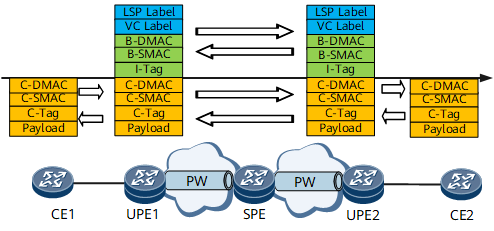PBB VPLS Fundamentals
Related Concepts
PBB VPLS divides an HVPLS network into an access VPLS domain and a backbone VPLS domain by deploying I-VSIs and backbone-virtual service instances (B-VSIs) on access-, aggregation-, and core-layer devices. In the access VPLS domain, I-VSIs provide VPLS services; in the backbone VPLS domain, B-VSIs provide VPLS services.
Concept |
Description |
|---|---|
PBB |
PBB, a technique defined in IEEE 802.1ah, precedes C-MAC addresses with B-MAC addresses in user packets to separate the user network from the carrier network. This implementation enhances network stability and eases the capacity pressure faced by SPEs' MAC forwarding tables. |
I-VSI |
An I-VSI processes user-side MAC address information, encapsulates packets into PBB frames, and is bound to an attachment circuit (AC) interface for local customer edge (CE) identification. |
B-VSI |
A B-VSI processes B-MAC addresses and uses the configured peer address to determine a PW's remote PE. |
I-VSI-B-VSI binding |
PBB VPLS uses both I-VSIs and B-VSIs. Multiple I-VSIs can be bound to the same B-VSI. SPEs are aware of only B-VSIs. |
UPE |
A UPE is an aggregation device that directly connects to CEs. A UPE has to connect to only one SPE on an HVPLS network. A UPE supports routing and MPLS encapsulation. If a UPE connects to multiple CEs and possesses the basic bridge function, the UPE can perform frame forwarding to reduce the burden on the SPE. |
SPE |
An SPE connects to all UPEs and all the other SPEs on an HVPLS network. From the perspective of an SPE, its connected UPE acts as a CE, and the PW set up between the UPE and itself serves as an AC. An SPE has to learn the MAC addresses of connected UPE interfaces as well as the MAC addresses of sites connecting to these UPEs. |
PBB PE (PPE) |
On a PBB VPLS network, a PPE can connect to UPEs, CEs, and SPEs. |
Implementation
Figure 1 describes each field in a PBB packet, and Table 2 shows the transmission of a user packet on a PBB VPLS network.
Packet |
Description |
|---|---|
Payload |
User packet. On a PBB VPLS network, the payload is transparent to UPEs and SPEs. |
C-Tag |
Used to identify a user VLAN. On a PBB VPLS network, UPEs and SPEs do not need to learn C-tags. |
C-SMAC |
Source C-MAC address. On a PBB VPLS network, only UPEs need to learn C-SMAC addresses. |
C-DMAC |
Destination C-MAC address. |
I-Tag |
An instance tag (I-Tag) is a field defined in 802.1ah for the MAC header. It is used to transmit frame-related service instance information. The I-tag is inserted before user MAC addresses. It is a 4-byte field and includes a 2-byte Ethtype and a 2-byte I-SID. Ethtype 0x88e7 identifies a PBB packet. The I-SID defines a frame-related service instance and uniquely identifies an I-VSI. Upon receipt of a user packet, the UPE adds the I-tag to the packet to identify the corresponding I-VSI. On a PBB VPLS network, SPEs do not need to learn I-tags. |
B-SMAC |
Source B-MAC address. On a PBB VPLS network, SPEs have to learn B-SMAC addresses. |
B-DMAC |
Destination B-MAC address. On a PBB VPLS network, SPEs have to learn B-DMAC addresses. |
VC Label |
Label used to identify a VC. |
LSP Label |
Label used to identify an LSP. |
After a user packet arrives at the AC interface of UPE1, UPE1 obtains I-tag, B-SMAC address, and B-DMAC address information from the I-VSI, and adds a PBB header containing the B-DMAC address, B-SMAC address, and I-tag to the packet in addition to adding the VC and LSP labels to the packet. Then, UPE1 searches the I-VSI forwarding table for a matching entry to forward the packet. If a matching entry can be found, UPE1 forwards the packet to the SPE. If a matching entry cannot be found, UPE1 broadcasts the packet in the corresponding B-VSI, which may have two PWs working in primary/secondary mode or multiple PWs.
If the packet is destined for another CE connecting to UPE1, UPE1 directly forwards the packet to target AC interface based on I-VSI information.
Upon receipt of the packet, the SPE determines the VSI to which the packet belongs and searches the VSI MAC address table for a matching B-DMAC address. After finding a matching B-DMAC address, the SPE unicasts the packet over a PW to UPE2. If the SPE cannot find a matching B-DMAC address, the SPE broadcasts the packet to UPE2. Because the SPE learns only the B-SMAC address of UPE1, the MAC address learning pressure of the SPE is not heavy.
Upon receipt of the packet, UPE2 determines the B-VSI to which the packet belongs based on the VC label and determines the corresponding I-VSI based on obtained I-tag information. UPE2 then compares the B-DMAC address carried in the packet with the B-SMAC address of itself. If the two addresses are the same, UPE2 removes the outer label and PBB header from the packet, searches the I-VSI's MAC address table for an AC interface mapped to the C-DMAC address that is carried in the packet, and forwards the packet to CE2 through the AC interface. Otherwise, UPE2 drops the packet. UPE2 learns the B-SMAC address carried in the packet to forward returned traffic.

If the B-DMAC address carried in the packet is a multicast MAC address, UPE2 directly forwards the packet to CE2 without comparing this address with the B-SMAC address of itself.
A B-SMAC address can be configured in either an I-VSI or a B-VSI. If an I-VSI and the B-VSI to which the I-VSI is bound have different B-SMAC addresses, the B-SMAC address configured in the I-VSI takes effect.
